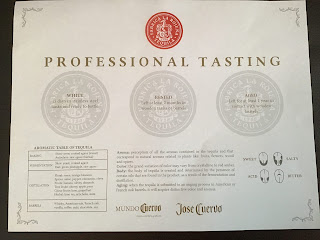We first smelled the aroma of the white tequila (no oak barrel for this one). To get the proper aroma, you had to tip the glass sideways as much as possible with spilling it. This allowed for the largest area of surface air over the tequila. Then you’d bring it up to your nose smelling first the aroma at the bottom of the glass lip before smelling the aroma at the top of the lip of the glass. The smell was different. Not sure if they use the word “bouquet” for the aroma of the tequila or not, as they do with wine. Anyway, our guy did not use that word.
 |
| Our guide knew his tequila! |
Next, we “enhanced” our sense of smell. We took the lime sliver, and twisted it to get its flavor stronger before we brought it to our nose. Then we tipped the glass and smelled the aroma again. It was definitely a different aroma.
Then, we tasted the tequila. We did this by putting a bit in the front of our mouth, swishing it through our teeth, and then swallowing. Lastly, we put a bit of the lime in our mouth and did the taste test again to see how the taste differed. The key was to just put a tiny bit in your mouth; otherwise, it really burned in your mouth and one the way down. I learned the hard way!
Then we followed the same procedure with the two-month plus aged tequila, the light golden one. This time, though, we used the sweet agave to enhance the smell and taste.
Next we used the same procedure with the one-year plus aged tequila, the one on the left in the picture. To enhance aroma and flavor here we used the cinnamon. We also starting looking at the “legs” of the tequila. For this one, the legs were evident and came down in tiny rivulets, much as it does with good wine.
 |
| If you look closely, you can see the legs about a third of the way down from the top of the glass |
And then came the prized tequila, the one that was aged the longest and was in the brandy glass. We followed the same process of tipping the glass sideways, etc. This time, for the aroma and taste enhancer, we used the coffee bean.
Here is a copy of our “professional tasting” form:











No comments:
Post a Comment